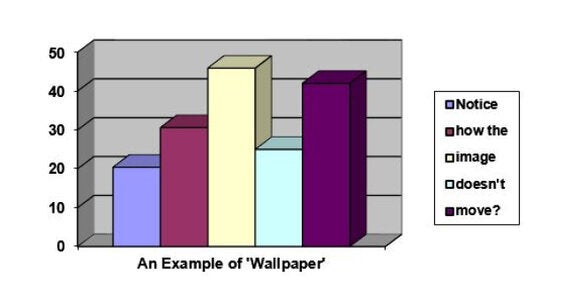
We live in a relatively tech-savvy world. Most of us know our way around a PC, Mac, smartphone, and tablet. Some of us can even rhyme off a few web-based companies that aren't named Google. (There's Cisco Systems, and and um... is Western Digital still a thing?)
The point is, we're a lot more adept with 'computer speak' than we used to be. Which makes it all the more head-scratching that the following conversation continues to take place across North America:
"Hey, I love your new screensaver!"
"Well, actually it's wallpa--"
"I'm off to get a latte! Bye-ee!"
Such exchanges have got to stop.
Yes, screensaver vs. wallpaper. Can some form of reconciliation be found? Not since the landmark cases of Roe vs. Wade and Joe vs. the Volcano has such frustration been bestowed upon an issue.
Permit me to use this article as a forum for education. For it is time that we as a culture come together, put aside our differences, and formulate the important distinction between wallpaper and screensaver. Most of us, when pressed on the issue, can make the right call. But to the unknown percentage of the continent that needs a little prodding, I offer this quick refresher.
The screensaver, as a rule, is designed to prevent one's display from being afflicted by the condition known as 'screen burn'. Consider it to be the monitor's SPF 30. The screensaver image is often in constant motion, like a small army of termites gobbling up your home's foundation. Which means no specific cluster of pixels is ever in use long enough to be permanently 'burned' into your display. Ever go to an ATM and find you're able to make out the faint outline of 'Please Insert Your Card' on every subsequent screen you access? That's your screen burn right there. Why do you think you have to pay those $2.50 service charges all the time? It's to help them cover the cost of thousands upon thousands of replacement ATM monitors. See? You bank isn't evil -- it just suffers from a hefty lack of foresight.
Now let's flip over to the other side of the coin. The term 'wallpaper' comes directly from the Latin word 'wallpaper,' which describes 'a paper product used to cover one's walls.' In our fast-paced I.T. world, a computer's 'wallpaper' is the image one opts to have as a background for their desktop. Prior to the software boon of the 1980s, if a person were to suggest 'wallpapering their windows,' they'd likely be detained for a 48-hour psychiatric evaluation. (Or at the very least would have to settle on attending a rather second-rate interior design college).
For many, wallpapers are comprised of pictures of your kids. Or your wife. Or Angelina Jolie. If you happen to be Brad Pitt, you can check off all three options with the simple scanning of one family portrait. But to most of us, this is an unlikely option.
Now unless your kids are in constant motion on the screen in the same 'endearing' way they are at home, you've still got yourself wallpaper my friend, and not a screensaver. (Also, here's a pharmaceutical tip: Ritalin.) 'Lack of movement' is generally a sure sign you're dealing with wallpaper. And having a static video image of your family in front of you at work for eight hours a day may play a small part in saving your marriage, but it ain't gonna save the display on that old Sony E200 monitor you're still lugging around.
Which raises the question: Do folks confuse wallpaper for screensavers because they're inherently dense? You know, plagued by a congenital flaw brought on by suspect RNA sequencing? Or is this lack of common sense essentially a learned behavior, caused by a combination of environment and upbringing? Only Charles Darwin can truly answer this riddle, and given his current penchant for not being alive ('survival of the fittest' indeed, eh Chuck?) the answer appears to be buried with him. Or cremated with him. To be honest, I'm a tad sketchy on the specifics of his Living Will.

Don't get me wrong. For the most part people are only half-stupid. For although they may mistake your wallpaper for a screensaver, there is absolutely no chance of the reverse taking place. A screensaver, for reasons known to very few, is never, ever mistaken for wallpaper.
To many an ill-informed family member or co-worker, wallpaper can be construed as being both wallpaper and screensaver at the same time. In their view, the physical properties of both are attributed to the one. Are there any precedents to such a bizarre occurrence? Only two spring to mind. There's the theoretical realm of quantum physics, where matter is reputed to possess both wave and particle-like properties. And there's the realm of 1950s-based musicals, where the Greased Lightning is somehow recognized as being both systematic and hyrdromatic.
In the final analysis, I present you with this: through perseverance and proper education, I'm cautiously optimistic the distinction between wallpaper and screensaver can, in our lifetime, be made as clear as, say, Crystal Pepsi. Sadly, at this very moment, it appears to be as cloudy as the Crystal Pepsi marketing campaign. So in the meantime, to quote venerable Sergeant Phil Esterhaus of Hill Street Blues fame, "Let's be careful out there."
ALSO ON HUFFPOST:
